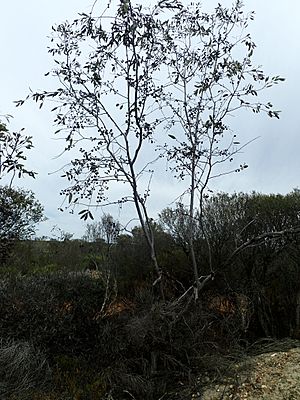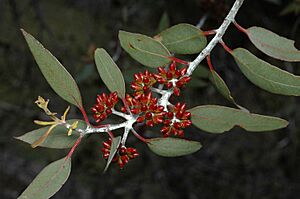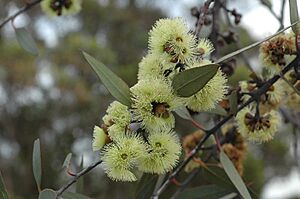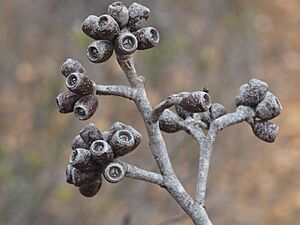Desmond mallee facts for kids
Quick facts for kids Desmond mallee |
|
|---|---|
 |
|
| Eucalyptus desmondensis near Ravensthorpe | |
| Conservation status | |
| Scientific classification | |
| Genus: |
Eucalyptus
|
| Species: |
desmondensis
|
The Desmond mallee (scientific name: Eucalyptus desmondensis) is a special type of eucalyptus tree. It is a slender, willowy plant that grows only in a small part of southwestern Western Australia. This means it is endemic to that area.
This unique plant has smooth bark and long, thin adult leaves. Its flower buds grow in groups of nine to nineteen. When they bloom, the flowers are a lovely cream or pale yellow color. After flowering, it produces cup-shaped or barrel-shaped fruits.
Contents
What Does It Look Like?
The Desmond mallee is a tall, thin plant that usually grows to be about 1 to 4.5 meters (3 to 15 feet) high. It has a special woody swelling at its base called a lignotuber. This helps it regrow after fires.
Its bark is smooth and can be whitish or pale brown. Sometimes, its branches droop down. The younger branches often have a slightly blue-green, waxy coating, which is called glaucous.
Leaves and Flowers
Young plants have stems that are almost square. Their leaves are egg-shaped, about 5.5 to 11 centimeters (2 to 4 inches) long and 2 to 5 centimeters (0.8 to 2 inches) wide.
Adult leaves are thick and shiny grey-green on both sides. They are shaped like a spearhead, about 5.5 to 11 centimeters (2 to 4 inches) long and 1.5 to 2.5 centimeters (0.6 to 1 inch) wide. These leaves grow on a stalk called a petiole, which is about 1.2 to 2 centimeters (0.5 to 0.8 inches) long.
The flower buds grow in groups of nine to nineteen. They are found where the leaves meet the stem. These buds sit on a flat, blue-green stalk called a peduncle, which is about 0.7 to 2 centimeters (0.3 to 0.8 inches) long. Each bud is oval-shaped, about 0.7 to 1.2 centimeters (0.3 to 0.5 inches) long and 0.4 to 0.6 centimeters (0.16 to 0.24 inches) wide. They have a cone-shaped cap called an operculum.
The Desmond mallee usually flowers between May and November. Its flowers are cream-colored or pale yellow.
Fruit
After the flowers, the plant produces a woody fruit. This fruit is shaped like a cup or a short barrel. It is about 0.5 to 1 centimeter (0.2 to 0.4 inches) long and 0.6 to 0.9 centimeters (0.24 to 0.35 inches) wide.
How It Was Named
The Desmond mallee was first officially described in 1925. Two botanists, Joseph Maiden and William Blakely, wrote about it. They used samples collected by Charles Austin Gardner in 1924.
The plant's scientific name, desmondensis, comes from a place called Desmond. This was a mining town near Ravensthorpe. The ending -ensis is a Latin suffix that means "from a place" or "belonging to a country."
Where It Grows
The Desmond mallee grows in a small area of southern Western Australia. You can find it in sandy plains and on rocky hillsides. It prefers stony clay, loam, or sandy soils that come from granite.
This plant is often seen around the Fitzgerald River National Park. It is easiest to spot along the road between Ravensthorpe and Hopetoun.
Is It Protected?
The Government of Western Australia's Department of Parks and Wildlife has classified the Desmond mallee as "Priority Four". This means it is rare or almost threatened.
Currently, all known groups of Desmond mallee plants are on private land or government land. None of them are in special conservation areas or national parks.






